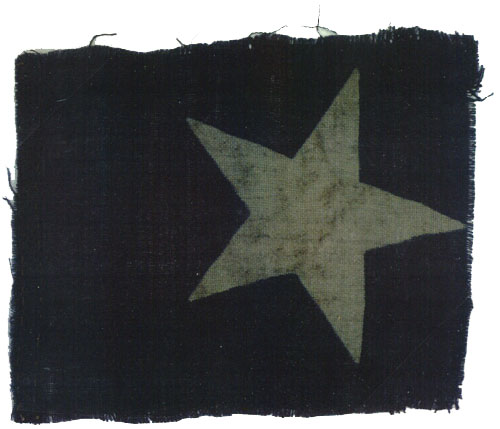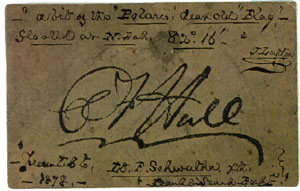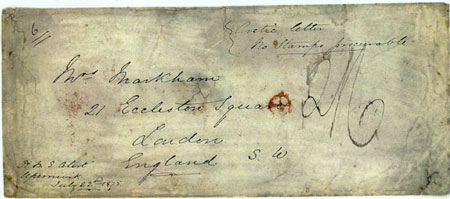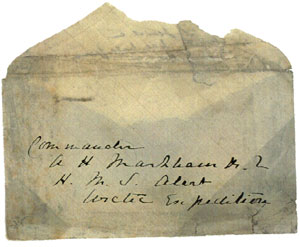They Found Land Where None Was
Known
| The 1872
Austrian expedition, led by Weyprecht and Payer, was commemorated
for the discovery of Franz Josef Land by a set of labels produced
by the Grillparzer club in Austria. Mail was not carried by the
expedition. |
British Arctic Expedition
1875
|
|
"Arctic
letter -- no stamps procurable"
The British
Arctic Expedition of 1875 worked in the remote northern section
of Greenland without mail service. Mail was picked up from the
cairn on Careys Island by passing ships.
The collected
mail was put in the postal service at first port of call.
|
|
|
Carried by favor . . .
Mail and
messages from England were left in the cache on Careys Island
for the British Arctic Expedition of 1875. Personal notes were
delivered to the cache as a personal favor.
The envelope
is identified by the handwriting as Mrs. Markham, and contains
an after thought note under the flap of the envelope.
"I
find our _______ has held firm. Marialys F."

|
The Jeannette
Expedition
1879
Preparation for the Arctic Expedition
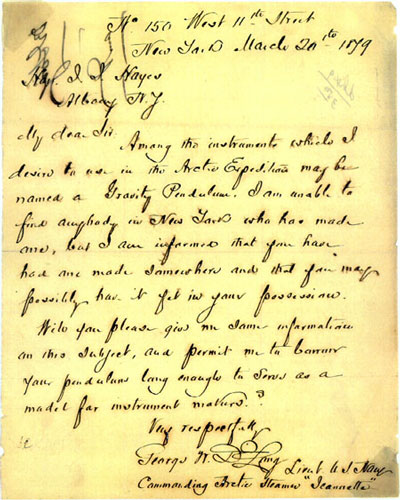
"When
we first came over on the west side of this sea Capt. Barns saw
the JEANNETTE, Bennets steamer going north for Herald
Island in the same lead of water that the whale ships worked north
in."
This
single paragraph, in a letter from Captain B.F. Homan of the Bering
Sea whaling fleet, recorded the last sighting of the first ship to
attempt to reach the North Pole by way of the Bering Strait. It was
also the last word of the JEANNETTE to reach
the world for two and a half years.
James
Gordon Bennett, editor of the New York Herald who had sent Stanley
into Africa to find Dr. Livingston, knew that a rescue expedition
could sell newspapers as nothing else could. Therefore, when the prolonged
absence of the Nordenskjöld Expedition became newsworthy he arranged
to purchase Sir Alan Young's yacht PANDORA a veteran
of two arctic voyages in search of the fate of Sir John Franklin,
and after renaming it JEANNETTE he presented it to the
United States government and insisted that they send it on an immediate
polar voyage. The government reluctantly agreed and commissioned Lt.
George Washington De Long to lead the party.
The JEANNETTE
is Sighted by Whalers
|
The 1879
attempt by De Long to drift across the polar basin failed because
of a mistaken placement of an island on the charts. The ship
was locked in the ice and finally crushed. Only three of the
crew survived by reaching Siberia.
Whalers
were prepared to exchange mail when they saw the ship, but the
weather prevented contact. Whalers sent personal mail with any
ship leaving the whaling grounds.
|
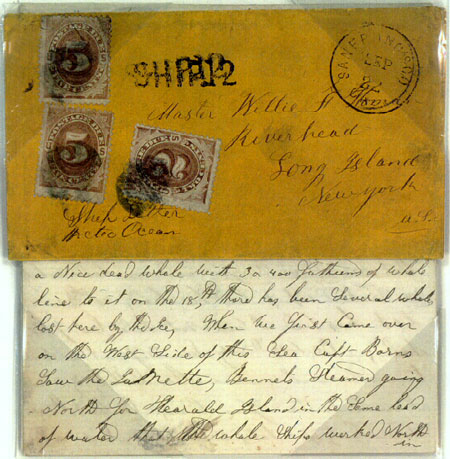
De
Long, who had his first taste of the Arctic when he participated in
the search for the POLARIS in 1872, theorized that the
best approach to the Pole was through the Bering Strait. After passing
over the pole he would search for Nordenskjöld. He supposed that
Wrangel Land, now known to be a small island, was a vast land mass.
In accordance with the principles of ocean currents the JEANNETTE
could follow its coast line northward until it could work no further
and then, if necessary, sledge parties could start out for higher
latitudes. He also hoped to prove that the warm Japanese current flowed
northward into the Polar Sea, resulting in a basin of open water somewhere
beyond the fringe of packed ice. This warm Japanese current through
the strait was expected to help in opening a path through the ice
pack.
The
experienced whaling captains told De Long that he was taking a deadly
course because all their experience denied the existence of such a
basin and more than one whaler was caught in the ice only to disappear
forever into the frozen north. Still there were some whalers that
agreed with De Long, as evidenced by another paragraph in Captain
Homan's letter:
"
. . . How beautiful and warm and pleasant it will be in that warm
sea around the north pole whare thare will be found all sorts of
life and sorts of sumer fruits, whare the sun shines 6 months in
a year and then have 6 months of night whare man can sleep or rest
from thare long sumers toil. What a lovely vineyard to live in.
How we envy Captain De Long."
The
ship left San Francisco on July 8, 1879 and after picking up dogs
and final supplies from the Alaskan Commercial Company's trading posts
at Michaelovsk they continued on to St. Lawrence Bay in Siberia, where
last minute mail was sent home, and then the great adventure was on.
The
crew was in high spirits as they passed through Bering Strait and
it was then that the SEA BREEZE, retreating
southward, sighted the JEANNETTE under full sail and
steam. They made an effort to hail her for the Eskimos had predicted
an early closing of the "pack" and the whalers had learned
to respect their predictions after more than thirty vessels were lost
as a result of ignoring this information in previous years. Lt. Danenhower's
narrative of the expedition recorded the meeting:
"On
September 4th a whaling barque bore down to us; we stopped engines
and awaited her approach, but the weather became misty and she did
not speak to us. We had an arctic mail on board at the time and
were disappointed at not being able to send letters home."
By
the following day the ice floes began to form around the vessel and
she was forced to drift with them. Each day De Long expected the ice
to loosen and allow them to drift free, but this never happened, finally
they drifted past Wrangel Land. Too late they discovered that it was
a tiny island instead of a continental land mass.
One
of the modern innovations of the JEANNETTE
was an invention by a man named Thomas Edison -- a generator which
was supposed to light the ship during the long dark months. No matter
how they tinkered with it they could not raise a single spark and
they finally discarded it convinced that the electric light would
never replace the oil lamp.
They
drifted for fourteen months suffering disappointments and escapes
until on May 16, 1881 they sighted land. It was only a small island
76 degrees north, which they named "Jeannette," and not
Franz Josef Land as they had hoped to reach by that date, but it was
land. This barren rock was the first land they had seen since sighting
Wrangel Island in 1879 and it must have served a heavy blow to their
waning hopes of survival. The vessel was now leaking at the rate of
two hundred gallons an hour from ice pressure and the crew was constantly
on the alert for an immediate evacuation. Suddenly on June 11, 1881,
the ice separated and the ship righted itself, but their joy turned
to horror when the ice closed again and the JEANNETTE
was broken in two and disappeared under the ice. The crew barely escaped
with their equipment.
The
only place to go was the Siberian coast where the available maps furnished
only rudimentary information. The story of the march over the ice,
dragging boats and equipment until all the dogs were dead or disappeared,
is one of the arctic epics of courage and willpower, but also desperation.
On
August 30, when they came to open water, the battered sleds and unnecessary
equipment was discarded. A deserted hut was found on the New Siberian
Islands and a week later more deserted huts were found on Koltenoi
Island. This was at least some sign of life. They were traveling in
three boats when a storm separated them. One group was never heard
from again. De Long's party landed on the Lena Delta, but were too
weak to continue and the third boat was lucky enough to hit the mouth
of one of the rivers that empty on the Lena Delta and were able to
sail up river until they found a settlement.
The
De Long party sent two men ahead for help, but their signs were misinterpreted
and they were taken to the settlement where Chief Engineer Melville
and First-mate Danenhower from the other boat were resting. By then
it was too late in the season to attempt a rescue and the bodies of
the De Long party were recovered the following spring. Word of the
disaster did not reach the outside world until the spring of 1882
because Yakutsk, the end of the telegraph line, was fifteen hundred
miles away.
(Exhibition
pieces courtesy of George Hall)
